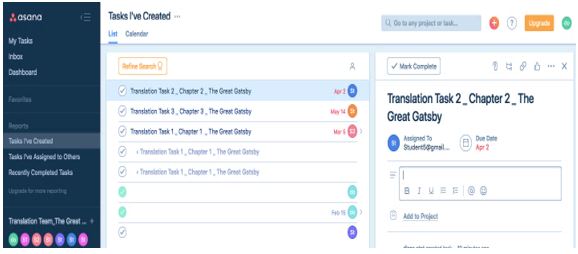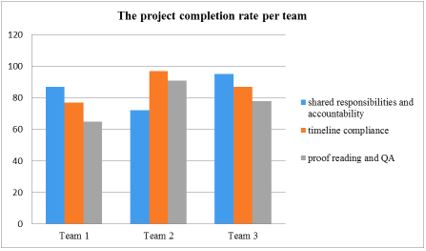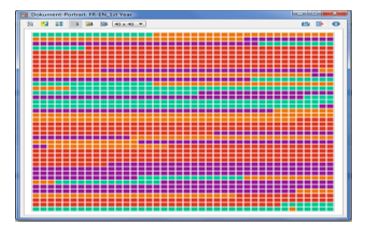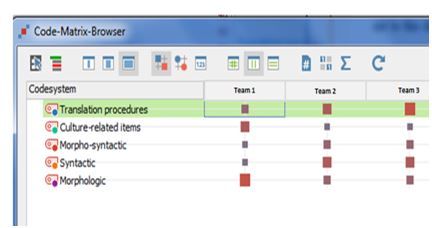Abstract
With a view to accommodating EU priorities for quality tailor-made training to secure trainees a rapid integration to the labour market, higher education institutions have embarked upon updating and harmonizing of Master’s programmes. In light of the recently adopted European Master’s in Translation (EMT) competence framework for 2018-2024 underpinning continuous professional development of service provision skills and technological progress on the translation profession, special attention is paid to build up students’ technological and strategic competences. The current paper is intended to map out an integrated training project, designed to enhance Master’s students’ translation competence in compliance with the contemporary quality standards. Within an interdisciplinary landscape, our project is aimed at familiarising students with corpus-based translation applications (CTS) and the input of CAT tools as effective strategies fostering resourcefulness, interactive online networking and good time management when dealing with large translation assignments against enforced deadlines. Targeting to guide our trainees in the investigation of larger electronic corpora by means of computer-assisted tools, we tackle the contemporary multifaceted translator’s competence from a
Keywords: Integrated training projectcorpus-based translation applicationsCAT toolsthe multi-layered translation competenceLearning by Doing
Introduction
The simultaneous introduction of corpora analysis to language teaching and translation training via Learner Corpus Research (LCR), as labelled by Granger in 1993, and Corpus-Based Translation Studies (CTS), initially launched by Backer in the same year, marked the turning point “in our understanding of how best to help students develop competence in the kinds of language they will encounter on a regular basis” (Biber & Reppen, 1998, p.157).
As far as the field of Translation Studies is concerned, various corpus-based investigations have been carried out in the attempt to establish new approaching strategies on “the nature of translated text as a mediated communicative event” (Baker, 1993, p. 243), while investigating the “linguistic features which typically occur in translated texts [as] almost inevitable by-products of the process of mediating between two languages” (Laviosa, 2002, p. 43). Once introduced by Baker back in 1993, the scope of CTS as an inter-disciplinary research paradigm has charted new territories to enhance translation competence. Baker (1995) regards corpora as “a collection of texts held in machine-readable form and capable of being analysed automatically or semi-automatically in a variety of ways” (p. 225). In the same line, Krüger (2012) highlights that corpus-based investigations are aimed “to describe characteristics of the translation product and the translation process or the function of a translation in its socio-cultural context and to feed this data to the theoretical branch of translation studies for testing explanatory hypotheses” (p. 502).
Corpus-based research studies propagated rapidly within the field of written and interpreted language, tackling various topics concerning not only the process and product of translation, as envisaged by Laviosa (2002) and Olohan (2004), but also the adapting of innovative training methods to update contemporary translation curricula, as recommended by Orozco and Hurtado (2002) and Fantinuoli and Zanettin (2015). According to Kruger, Wallmach and Munday (2011), CTS has gained nowadays the status of a major paradigm, harmonising novel analysis views with the contemporary landscape of Translation Studies. Contemporary mainstream literature reports the multiplication and diversification of corpus-driven studies, which, as highlighted by Laviosa (2010), have branched out Translation Studies to both well-established and novel research fields such as Corpus Linguistics, Information and Communication Technologies, Computational Linguistics, Machine (Assisted) Translation, Contrastive Linguistics, Terminology, Lexicography, and LSP studies.
Acknowledging the need for a cohesive development of translators’ competence, the European Master’s in Translation (EMT) partnership project between the European Commission (Directorate-General for Translation) and European higher institutions has recently updated the 2009 initiative to develop master’s level translation programmes and launched the strategy for the 2018- 2024 competence framework. As recommended by 2017 EMT Report, the project initiative shall rally to underpin pending joint training projects between universities and the translation industry within the filled of translation research and training, as to secure future service provision expertise, complemented by the constant upgrading of dedicated software and CAT tools.
Sharing the current outlooks on the didactic contribution corpus-based translation applications has brought to both trainers and trainees; we embarked upon an integrated training project carried out within a group of 30 Translation Masters’ students attending the
Problem Statement
In line with prominent scholars, such as Baker (1995), Laviosa (2002), Olohan (2004) and Kruger (2012), we highlight the twofold didactic input provided by translation-oriented corpora investigations. While Translation Studies theorists’ steady comparisons of ST (source-texts)
Considerably more productive, electronic comparable corpora have been intensively resorted to in translation training. Facing students with comparable corpora, trainers aim at increasing awareness with regard to different language and socio-cultural particularities revealed when comparing translated
We share the perspective put forward by Rodríguez Inés (2009, p. 133) that corpora-based investigations applied to translation studies outline the role of the trainer as the information facilitator, rather than information provider, “who develops the procedural knowledge of the students to enable them to gain declarative knowledge in a more autonomous way”.
In the same spirit, Kruger (2012), advocates that while the role of the trainer is modulated in favour of a more hands-on approach via “applied corpus-based translation studies” (Bernardini, Stewart & Zanettin, 2003, p. 1), corpora investigations reshape the translation training landscape by enhancing students’ self reliance and autonomy, underpinning encyclopaedic and text-mining knowledge, as well as an increased awareness to long-life professional development. Hence, engaging our students in a virtual translation project and assigning them different roles within a virtual translation agency, via
Research Questions
Subscribing to current translation teaching methodology views (Laviosa, 2010), aimed at developing a higher L2 command and intercultural communicative competence, in order to generate a bilingual interface that secures language mediation within complex socio-politic and cultural communicative events, we set out to test some novel translation training methods that facilitate service provision skills development to keep up with the cutting-edge translation technology.
Departing from the above mentioned didactic contributions corpora analysis may bring to round contemporary translators’ profile that meet current labour market requirements, we sought to investigate to what extent students’ strategic and technological competences can be developed via a computer-assisted simulation of a translation project. Resorting to smart process applications (Asana) and dedicated software for qualitative and mixed methods research (MAXQDA 12, https://www.maxqda.com), we set out to test the benefits of cutting-edge technology on the development of 2nd year Masters’ students translation competence, measuring at the same time our students’ participation and responsiveness degree within the simulated project.
Zooming in, we would question whether trainees’ L2 communicative competence and technological skills can be upgraded when faced with electronic comparable corpora investigations via computer-assisted tools. Moreover, by the end of the semester we would test whether post-translation corpus investigation tasks increase trainees’ analytical and critical thinking and enhance self-reliance with regard to their translation choices.
Purpose of the Study
Plugging our students in the translation market realities and challenging them with authentic translation tasks that require effective time planning and resources management, we seek to raise their awareness on the importance of professional training and lifelong learning. Observing the strategic agenda established for the 2018-2024 EMT competence framework, our three-stage project design and implementation focused on the development of 2nd year Masters’ students translation competence via smart process applications and dedicated software for qualitative and mixed methods research.
Within the early stage of our project we framed an integrated translation environment to build-up strategic skills via procedural knowledge and dedicated software. Simulating the workflow of a translation agency, we divided the students into tree teams, each made up of 5 members assigned to:
- translate into Romanian the first three chapters of Fitzgerald’s
- monitor the internal workflow in relation to the pre-set project timeline and the interim deadlines;
- provide proofreading services and comply with QA norms before project completion.
After creating the and renaming the project -

The second stage of the project, the operating stage, was aimed at increasing students’ autonomy, allowing them to choose the best translation solutions at linguistic, cultural and procedural level.
Facilitating the students with permanent access to the Asana software, they were encouraged to cooperate interactively, to participate remotely and ask questions in real-time. The software enabled all project members to visualise their tasks and due deadlines according to the project operative timeline, to communicate on various topic-related matters and to share large pdf and word files. Also, Asana offers a user-friendly interface that assists users to track their progress and stay up to date with co-workers workflow. Selecting the
Within the last stage of the project, the follow-up stage, students were asked to compare their deliverables with the official Romanian translation
During each implementation stage, we carried out parallel monitoring activities to register trainees’ degree of involvement, interactivity and responsiveness towards smart technologies and corpus-based investigations applied to the assigned tasks. Such investigations were aimed at establishing some major tendencies in relation to students’ translation difficulties, and, hence, the implementation of some corrective training measures, which, in the long run, could contribute to future syllabi review.
Research Methods
To design and implement our research study we adopted the model put forward by Krüger et al. (2011). Thus, we resorted to corpus-based investigations and comparative analyses in order to look into the applicability degree of the training methods applied to develop trainees’ strategic and technological skills, as operative dimensions of the contemporary multi-layered translation competence. As far as the translation process and product are concerned, we sought to induce the same research method to our students via button-up practice activities. Our investigation was framed by applying both quantitative and qualitative research methods. By simulating the translation agency project and assigning students with parallel corpora comparison tasks, we aimed at establishing the nature and the incidence rate of frequently encountered difficulties in terms of language choices, the transfer of culture-related items and the appropriateness of translation strategies when rendering a certain SL concept into the TT. To frame our project we took up Laviosa’s (2010) translation training approach. The design and implementation of our customised translation project envisaged to re-map the teaching-learning process and to stimulate an interactive environment via knowledge exchange and mutual cooperation. Hence, we set out to build-up our students’ translation skills and competences that meet current demands of the contemporary translation market.
The implementation of the translation project, as well as our parallel monitoring assessments focused on comparative corpus-based investigations, carried out via qualitative and quantitative research methods. The key stages in the development of our projects underpinned both immediate practical results, i.e. the development of the multi-layered translation competence and enhancement of trainees’ self-reliance and autonomy, as well as the systematic development of thematic maps and workbenches as open sustainable translation resource that can be further extended and complemented.
Findings
Our computer-based simulation of a translation agency project and the results recorded in the follow-up stage validate the hypotheses of the research study that corpus-based translation applications contribute to the enhancement of trainees’ self-reliance and autonomy, developing operational skills such as strategic planning of service provision and technological competence.
According to our parallel monitoring surveys carried out at each implementation stage of the training project we could establish that:
Computer-assisted activities increased students’ active participation within translation training seminars; 90% of the trainees (at least 20 of our thirty-group students) joined the project enthusiastically and overcame early-stage reluctance to novel digitalised tools.
Button-up translation tasks stimulate proactive cooperation and responsiveness. All 30 members of the 3 teams took up and completed their tasks in a responsible manner both horizontally, as they contributed to the progress of the team, and, vertically, complying with the translation assignment requirements.
Students’ strategic competence improved with the upgrade of each project stage. All 30 team members succeeded to share internal responsibilities and comply with the pre-set deadlines and QA norms. Acting autonomously, our students managed to plan and make most appropriate decisions in order to complete the tasks.
As registered in Figure
share responsibilities and remain accountable, seeking for operational and process solutions (72% - 95% fulfilment rate);
comply with interim and final deadlines (77% - 97% fulfilment rate);
observe QA norms imposed for the translation delivery (65% - 91% fulfilment rate).

Aimed to improve our students’ translation competence and technological skills, the follow-up results of their corpus-based investigation tasks revealed that most frequently encountered difficulties were related to the proper application of translation procedures, 14 out of 30 students (46,6%), followed by language-related obstacles, where about 21 of our 30 students (31,7%) encountered difficulties. 5 of our 30 students faced some problems when challenged with the transfer of culture-related items (15%). To better illustrate our findings, we imported our students’ corpus-based reports delivered via Asana in MAXQDA 12 - Software for Qualitative and Mixed Methods Research. The imported corpus was then encoded according to the research variables set previously:
the adequacy of the applied translation procedures – red
language difficulties – green (lexical) and orange (syntactic)
the transfer of culture-related items – purple


Departing from this colour-based comparison method, we selected the
Our quantitative analysis was complemented by a distribution chart of the codes in relation to the pre-set variables. The
The results obtained following our parallel computer-based corpus investigation, validate that our students faced considerably more difficulties when selecting the most appropriate translation procedures rather than when transferring ST culture-related items into the TT. At language level, a mild rising trend is registered in the frequency rate of syntactic difficulties as compared to lexical ones (Figure
Conclusion
To keep up with the diversification and multiplication of current translation market we designed and implemented a computer-assisted translation agency project simulation to test the methodological input of smart process applications and dedicated software applied to translation training seminars.
Resorting to inductive translation-oriented activities, we aimed to shed some light on the importance of interdisciplinary research activities carried out in the field of translation and cultural studies via corpus-based translation applications and smart technologies. The development of our project was closely monitored at each implementation stage and the results registered indicated an increased involvement degree on behalf of the subjects. At the same time, our trainees manifested a sound team-spirit commitment and strategic thinking towards the successful completion of the project, while the responsiveness rate to smart technologies and corpus-based investigations applied to translation tasks ranged between 17 to 28 students (55% to 94%) per subject and between 23 to 29 students (75% to 98%) per team. Also, the
Plugging our students in the translation market realities and challenging them with authentic translation tasks that require effective time planning and resources management, we sought to raise their awareness on the importance of professional training and lifelong learning. In the long run, the results obtained may contribute to future syllabi reviews and open the door for interdisciplinary and intercultural collaborative measures that can team up linguists and translation trainers to bridge the gap in the development of novel training methods applied to Translation Studies.
References
- Asana - https://app.asana.com.
- Baker, M. (1993). Corpora in translation studies. An overview and some suggestions for future research. Amsterdam and Philadelphia: John Benjamins.
- Bernardini, S., Stewart, D., & Zanettin, F. (Eds.). (2003). Corpora in translator education: an introduction. Manchester: St. Jerome.
- Biber, D., & Reppen, R. (1998). Comparing native and learner perspectives on English grammar: a study of complement clauses. In S. Granger & J. Hung (Eds.), A bird’s eye view of computer learner corpus research (pp. 10-13). Oxford: Oxford University Press.
- Bowker, L., & Pearson, J. (2002). Working with specialised language. A practical guide to using corpora. London: Routledge.
- European Commission (2017). European Master’s in Translation (EMT) Annual report [Retrieved from https://ec.europa.eu/info/sites/info/files/emt_annual_report_2017_en.pdf.
- Fantinuoli, C., & Zanettin, F. (2015). New directions in corpus-based translation studies. Berlin: Language Science Press.
- Fitzgerald, F., S. The Great Gatsby. Retrieved from https://www.planetebook.com.
- Fitzgerald, F., S. The Great Gatsby (Marele Gatsby). Tranlsation by Goșu, S., Bucureşti: Corint Books. Retrieved from http://www.edituracorint.ro.
- Granger, S., (1993). The international corpus of learner English. In J. Aarts, P. de Haan & N. Oostdijk (Eds.), English language corpora: design, analysis and exploitation (pp. 57-69). Amsterdam: Rodopi.
- Ginger Translation - https://www.gingersoftware.com
- Kruger, A., Wallmach, K., & Munday, J. (2011). Corpus-based translation studies: research and applications. London and New York: Bloomsbury Academic.
- Kruger, A. (2012). Working with corpora in the translation classroom. In Studies in second language learning and teaching. Department of English Studies, Faculty of Pedagogy and Fine Arts, Adam Mickiewicz University, Kalisz SSLLT 2, (pp.505-525). Retrieved from http://www.ssllt.amu.edu.pl.
- Laviosa, S. (2002). Corpus-based translation studies. Theory, findings, applications. Amsterdam: Rodopi.
- Laviosa, S. (2010). A transcultural conceptual framework for corpus-based translation pedagogy. [Keynote lecture] The International Symposium on Using Corpora in Contrastive and Translation Studies 2010 Conference (UCCTS2010), 27-29 July 2010. Retrieved from https://www.lancaster.ac.uk/fass/projects/corpus/UCCTS2010Proceedings/
- MAXQDA 12 - www.maxqda.com
- Olohan, M. (2004). Introducing corpora in translation studies. London: Routledge.
- Orozco, M., & Hurtado, A. (2002). Measuring translation competence acquisition. Meta: journal des traducteurs/ Meta: translators’ journal, 3, 375-402. DOI:
- Rodríguez Inés, P. (2009). Evaluating the process and not just the product when using corpora in translator education. In A. Beeby, P. Rodríguez Inés, & P. Sánchez-Gijón (Eds.), Corpus use and translating. Corpus use for learning to translate and learning corpus use to translate (pp. 129-149). Amsterdam: John Benjamins.
Copyright information

This work is licensed under a Creative Commons Attribution-NonCommercial-NoDerivatives 4.0 International License.
About this article
Publication Date
15 August 2019
Article Doi
eBook ISBN
978-1-80296-066-2
Publisher
Future Academy
Volume
67
Print ISBN (optional)
-
Edition Number
1st Edition
Pages
1-2235
Subjects
Educational strategies,teacher education, educational policy, organization of education, management of education, teacher training
Cite this article as:
Oţăt*, D. (2019). Smart Technologies Assisting Translation Training. In E. Soare, & C. Langa (Eds.), Education Facing Contemporary World Issues, vol 67. European Proceedings of Social and Behavioural Sciences (pp. 1409-1417). Future Academy. https://doi.org/10.15405/epsbs.2019.08.03.173
